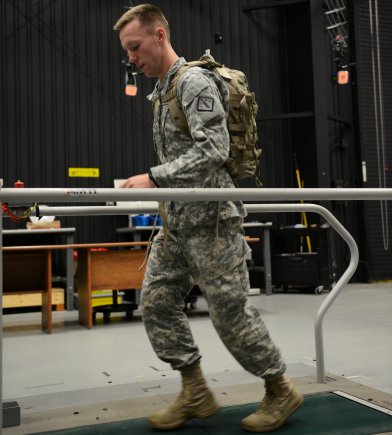How It Works
A frame mounted to the standard-issue assault pack contains a two-spring, rack-and-pinion suspension system that allows it to gently glide up and down as the Soldier is walking or running, Webster said.
As the assault pack moves, the mechanical energy produced by the motion recharges the Soldier’s battery, she said.
The other thing that happens is that the up-and-down motion is gradual and controlled. Without the attachment, this is not the case, she said, providing a comparison to a backpack full of school books that “bounces and slams your shoulders when running.”
Perhaps the biggest limitation of the device, Webster said, is that it weighs 15 pounds. That’s not insignificant because Soldiers are already heavily loaded down.
The weight offset would be fewer batteries to carry, and each battery is about the size of a paperback novel – not the tiny batteries found in stores. The other offset would be creating a lighter device. But that would be in the future, she said. For now, testing for weight wasn’t a goal, “we’re just trying to determine the energy output we get. We need that knowledge first before proceeding.”

Brian Wang is a Futurist Thought Leader and a popular Science blogger with 1 million readers per month. His blog Nextbigfuture.com is ranked #1 Science News Blog. It covers many disruptive technology and trends including Space, Robotics, Artificial Intelligence, Medicine, Anti-aging Biotechnology, and Nanotechnology.
Known for identifying cutting edge technologies, he is currently a Co-Founder of a startup and fundraiser for high potential early-stage companies. He is the Head of Research for Allocations for deep technology investments and an Angel Investor at Space Angels.
A frequent speaker at corporations, he has been a TEDx speaker, a Singularity University speaker and guest at numerous interviews for radio and podcasts. He is open to public speaking and advising engagements.


